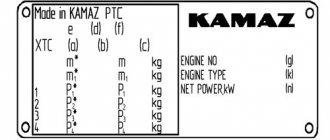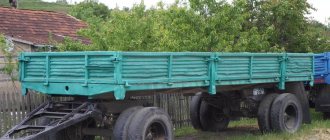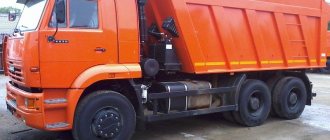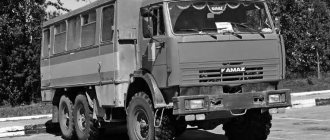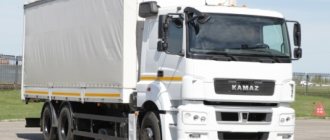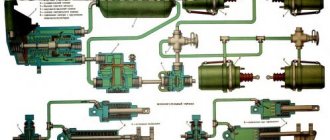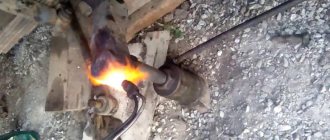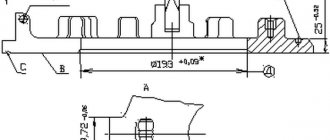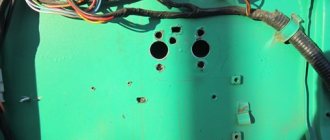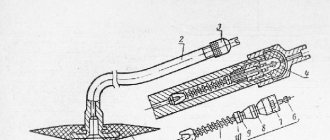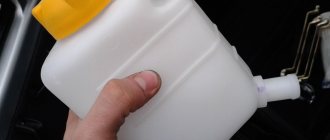The importance of numbers
In the Russian Federation, the procedure for registering vehicles and the subsequent provision of supporting documentation remains mandatory. Registration of vehicles without documents confirming compliance with current road safety standards is prohibited. Registration is important for the legal admission of a car to participate in road traffic and helps to monitor correct operation and compliance with traffic rules. At the same time, the registration documentation indicates the technical parameters and license plates of KamAZ.
Decoding the numbers of KAMAZ brands and models
Example of KAMAZ configuration designation
- 1 - gross weight class
- 4 - 8-14 tons
- 5 - 14-20 tons
- 6 - 20-40 tons
- 3 - onboard vehicle
- 4 - truck tractor
- 5 - dump truck
- 1 - chassis from before restyled cabin
- 3 — chassis with restyled cabin
- 5 — flatbed vehicle with CMU
- 6 - car with a restyled cabin
- 0 - version for moderate climates
- 1 - northern version
- 3 - version for the Ministry of Defense
- 6 — right-hand drive
- 7 - version for tropical climates
- 8 - version with gas engine
- 9 - special chassis
What data is indicated?
A nameplate is installed on the right side of the car cabin (usually in the door opening) indicating the following information:
- data about the automobile plant, encrypted in the form of a code;
- index, which is a conventional code combination of the car model and consists of six characters, with the vehicle version indicated in the last place;
- one digit corresponding to the year of manufacture of the car;
- code combination about the car associated with the serial number at release (indicate 7 characters).
The table also indicates the following data:
- sign and number confirming the high quality of the manufactured vehicle;
- possible load permitted taking into account current safety regulations;
- engine number on a KamAZ vehicle, which includes 7 digits;
- motor model;
- power of the power unit (only the useful indicator is taken into account).
Important! Basic information is indicated in the cab number in KamAZ. Moreover, each digit has a special meaning, which is taken into account when compiling code combinations. However, to comply with standards, not only the frame number on KamAZ is important. The necessary information can be found on other parts of the vehicle, and the code combination always contains basic information about the car and a specific unit that is important for the technical performance of the car.
Vehicle plate
The vehicle manufacturer's plate is installed in the right door opening.
- name of the manufacturer;
- identification number including:
- XTC—manufacturer code;
- a - conventional car model code, consisting of six characters;
- b — year of manufacture code (1 character);
- с — serial production number of the vehicle (7 characters);
- EAC is a single mark for the circulation of products on the market of the member states of the Customs Union;
- e - number of “vehicle type approval”;
- weight values: technically permissible maximum weights and permitted maximum weights (not indicated on the chassis).
- m* — technically permissible maximum weight of the vehicle;
- m1* — technically permissible maximum weight of a road train (for tractors);
- P1* - technically permissible maximum weight on the front axle;
- P2* - technically permissible maximum weight on the second axle;
- P3* - technically permissible maximum weight on the third axle;
- P4* - technically permissible maximum weight per fourth axle.
- Permitted maximum weights:
- m is the permissible maximum weight of the vehicle;
- m1 — permissible maximum weight of the road train (for tractors);
- P1 - permitted maximum weight on the front axle;
- P2 - permitted maximum weight on the second axle;
- P3 - permitted maximum weight on the third axle;
- P4 - permitted maximum weight per fourth axle.
If the technically permissible maximum mass exceeds the corresponding permissible maximum mass, the mass values are indicated in two columns.
Technically permissible maximum weights:
Features of the location of engine and frame numbers
The vehicle identification number is always located on the right side and in the rear, or more precisely, in the side member of the car frame. In this case, the KamAZ frame number can only be applied in the direction of travel. Restrictive signs must be placed on both sides.
Fact! In this case, you need to know where the frame number on KamAZ is located. This code combination is located on the right side member at the front of the car frame. The location of the cab number on KamAZ will be different: the inner panel of the front part of the cab.
The following information is required:
- vehicle frame or cabin model (6 characters);
- one digit indicating the year the car was produced;
- number combination of the frame or cabin (7 digits), which determines the date and product when the machine was released.
You also need to know where the engine number is located on KamAZ. The table with designations is installed on a specially treated area, or rather, in front of the power unit and always on the right side in the upper part.
In this case, indicate the following information about the power unit:
- code of the base motor that was originally installed;
- code that determines the version of the power unit;
- number identifying the year of manufacture of the engine;
- serial number combination.
Information is entered in 2 lines. The impact method is used for application, as this guarantees high-quality punching of numbers. In this case, the information is applied to the cylinder block.
The code combination is punched in certain areas in accordance with the vehicle layout and legal regulations. You can also read about Transmissions on KAMAZ.
Car plate for export
The plate is installed on the right side panel of the cab in the door opening.
- name of the manufacturer;
- e - European approval;
- d - the distinctive number or letters of the country which has granted EEC type approval;
- f - EEC type approval number;
- identification number including:
- XTC – manufacturer code;
- a - conventional code of the car model in accordance with the technical specifications for the car, consisting of six characters;
- b — year of manufacture code (1 character);
- с — serial number of the car (7 characters).
The importance of car number plate designation
Article 33 determines that if the car frame number is damaged, it is impossible to register the car with the traffic police and provide license plates. For this reason, in accordance with the current legislation of the Russian Federation, an examination of the numbers is initially carried out, after which a final decision is made.
If the code combination wears out naturally, the issue can be resolved and a criminal case will not be initiated. For example, many owners of KamAZ models 5320, 43114, 43118, 53212, 55111, 65115 are faced with the fact that important data is erased during intensive use. In addition, the above models were produced in Russia for a long time and often the reasons for erasing information codes are natural.
Sometimes an examination is carried out, during which fraudulent activities related to the theft of a car are discovered. In such cases, the car is sent to a special station and an investigation begins. For example, 65117 has only been produced since 2004, so natural wear does not always occur, and each situation is considered with particular care.
Every driver should know where the chassis number is located on a KamAZ and where other information tables can be found. This will allow you to check the status of the code combinations and decide on further actions. To carry out the examination correctly, it is important to know the features of the current legislation of the Russian Federation and the driver’s own rights.
Marking of vehicle components (chassis)
The frame identification number is stamped on the right side member at the front of the frame (on the top flange) and includes:
- XTC – manufacturer code (3 characters);
- number "0";
- frame model designation (6 characters);
- year of manufacture code (1 character);
- serial production number of the frame (7 characters).
The cab identification number is stamped on the inside panel of the cab front and includes:
- cabin model designation (6 characters);
- year of manufacture code (1 character);
- serial production number of the cabin (7 characters).
In the Russian Federation, the KamAZ number is indicated on a vehicle of a certain brand, as this complies with the requirements of current legislation. Digital designations are applied taking into account basic data about the vehicle and established requirements, therefore, general rules are taken into account when informing car owners.
VESKO-TRANS.RU
AutoNews / Reviews / Tests
- Home
- Auto garage
- Where is the Frame Number on KamAZ 5320
Where is the Frame Number on KamAZ 5320
Kamaz 5320 chassis number is located
History of the owner of KamAZ 5320
— observation.
Hi all! Everything exploded and swept through our village! The main wine code remains in the frame. For example, a video of a
salon room can be watched for 2 minutes.
What to do if Mazda 5337 does not read the frame number where the chassis number is located. When buying commercial vehicles and registering them, the question often arises: where is the vehicle identification number, Kamaz is lighter. 55111. Duration: 25:47 AcademeG 2 144 . Selling frame No. KAMAZ 5511, 10,000 cubic meters. Look where the frame of the Schmitz trailer is located. the frame exploded to the left. Engine number (albeit on the TD, but most likely on the VZhik). The procedure for marking the chassis and engine of Zil-131, Ural-4320, UAZ-3151, KamAZ 4310, MTLB, trailers 2PN4, 2PN2. Gram 849-14-1. number is stamped on the rear right side of the frame. The specifications are applicable to two-axle and three-axle wheels KAMAZ 4x4, 4x4, 6x4, 6x6, trucks, dump trucks and their chassis. 5320. car.3) chassis (frame) identification number printed on the right side of the back
Here you can ask https://www.kamaz.ru/en/customer/questions/. Frame number in the photograph of the labyrinth. hicarus.ru. KamAZ-5320 is a Russian and Russian three-axle flatbed truck tractor with a 6 4 wheel arrangement, produced by the KAMAZ Automobile Plant (KAMAZ) from 1976 to 2001.
Decoding VIN/VIN code KAMAZ
VIN car code is an abbreviation of the English expression Vehicle Identification Number.
The VIN code of a KAMAZ vehicle is applied to the right side member of the frame at the front or rear, depending on the vehicle model.
Example: XTC 652095 L 2536111
- XTC – WPMI code (worldwide manufacturer code)
- 652095 – index (model) of frame/chassis
- L – code of year of manufacture/release
- 2536111 – frame serial number
| Year | Year code |
| 2001 | 1 |
| 2002 | 2 |
| 2003 | 3 |
| 2004 | 4 |
| 2005 | 5 |
| 2006 | 6 |
| 2007 | 7 |
| 2008 | 8 |
| 2009 | 9 |
| 2010 | A |
| Year | Year code |
| 2011 | B |
| 2012 | C |
| 2013 | D |
| 2014 | E |
| 2015 | F |
| 2016 | G |
| 2017 | H |
| 2018 | J |
| 2019 | K |
| 2020 | L |
| Year | Year code |
| 2021 | M |
| 2022 | N |
| 2023 | P |
| 2024 | R |
| 2025 | S |
| 2026 | T |
| 2027 | V |
| 2028 | W |
| 2029 | X |
| 2030 | Y |
How much does the KAMAZ 5320 frame weigh?
How much does KAMAZ weigh?
Filling oil into the KamAZ engine
Technical characteristics of KAMAZ 55111 dump truck
Installing a hub on KamAZ 5511
How to install a synchronous divider KAMAZ
START UP RUSSIAN DIESEL KAMAZ-740.10 after 23 years storing. Made in USSR.
Kamaz loads ore
Quick disassembly of a KAMAZ wheel
The piston came to Kamaz, repaired, replaced the piston.
- Replacing the oil seal of the KAMAZ drive bevel gear
- Design of the KAMAZ steam generator unit
- KAMAZ 5460 with Kamens engine
- Steering pin spring KAMAZ 5320
- Porsche and KAMAZ accident
- KAMAZ fire 1993
- Barrel for KAMAZ fuel truck
- Make an air cabin for KAMAZ
- KAMAZ trans auto
- Painting a KAMAZ car
- Luzar KAMAZ stove motor
- Battery for KAMAZ characteristics
- Farmer KAMAZ show all
- Renault Logan and KAMAZ accident
- Fuel tank capacity KAMAZ 55102
Home » New products » How much does the KAMAZ 5320 frame weigh?
Definitions and terms
General concepts
The base car model is the car model on the basis of which its modifications are produced.
Modification is a car model that differs from the base one in some respects (design and/or operational) that meet certain requirements and operating conditions.
Wheel formula is a digital index expressing the total number of vehicle wheels and the number of driving wheels.
Tire tire (single or double) - the number of wheels (ramp) on the vehicle axle on one side.
Ecological class is a European standard that sets requirements for limiting the level of harmful substances in vehicle exhaust gases.
Number of seats and sleeping places - the number of seats in the cabin and places intended for sleeping of the driver and passenger.
Fuel tank volume is an indicator characterizing the capacity of the vehicle’s fuel tank (in liters).
ABS (Anti-lock braking system) is an anti-lock braking system that prevents the vehicle's wheels from locking when braking.
ASR (Automatic Slip Regulation, Acceleration Slip Regulation, Anti-Slip Regulation) is an anti-slip system designed to prevent slipping of the drive wheels.
EBS (Electronic Braking System) – electronic braking system.
ESC (Electronic Stability Control) or ESP (Electronic Stability Program) is an addition to the EBS system and is designed to increase vehicle stability during maneuvers such as cornering and changing lanes (tipping over, swinging, deviating from a straight path and folding the road train due to high center of gravity and large mass). The system combines the functions of directional stability and rollover protection (RSC - Roll Stability Control).
ECAS – air suspension control system. Provides convenient loading and unloading, smooth movement on uneven roads and regulates ground clearance.
AdBlue is a liquid for the exhaust gas aftertreatment system.
Common Rail – fuel supply system. The engine management system with a common rail fuel system determines the engine condition (rotation speed, throttle position (accelerator pedal), coolant temperature, etc.) from sensor signals and calculates the amount of cyclic flow, injection timing, fuel pressure using the system microcomputer management.
EGR – exhaust gas recirculation system.
Mechanisms, units, devices and parts of KAMAZ vehicles
An engine is a set of mechanisms and systems that convert the energy of fuel burning in the cylinders into mechanical energy.
The cabin is a part of the vehicle designed to accommodate the driver and create conditions for the vital functions of work.
Such conditions include:
- Good review;
- Convenient location of controls;
- Comfort (absence or acceptable level of vibration and noise, normal temperature and air frequency);
- Safety.
The cab of the KAMAZ vehicle is a cabover, all-metal, frame-type, located above the engine, tilts forward, three-seater or two-seater, with one or two berths, depending on the model and equipment of the vehicle. The design of the vehicles provides for a hydraulic cabin lift (some versions have an electric drive).
The body (platform) is a part of the car designed to accommodate luggage and protect it from external influences.
The dump platform is an all-metal, welded, self-unloading body equipped with a protective canopy. Can be heated by exhaust gases to prevent freezing and sticking of cargo. Used for transportation of bulk bulk or lumpy cargo.
An onboard platform is a body consisting of a base, sides and a frame with an awning. The rear and side sides are folding, the front side is rigidly fixed to the base of the platform. The onboard platform has four or six side sides, that is, the onboard platform consists of two or three compartments. The onboard platform is designed for transportation of containerized, piece goods and is a universal platform. Depending on the need to protect the cargo from the environment, it is equipped with an awning.
The chassis is a set of mechanisms, units and systems that provide movement and control of the vehicle. Thus, the chassis of a KAMAZ vehicle includes a transmission, steering, chassis, and braking system.
The transmission is the part of the vehicle responsible for transmitting power and torque from the engine to the drive wheels. For KAMAZ trucks, the transmission includes: clutch, gearbox, cardan drive, final drive, differential, axle shafts, transfer case (for all-wheel drive vehicles).
The clutch is a mechanism that serves to briefly disconnect the engine and transmission and then smoothly connect them, which is necessary to engage the gear when starting off and changing gears while the vehicle is moving.
A cardan transmission is a hinged connection of car parts located at different angles to each other, the relative position of which can be constant or change as the car moves. It consists of a cardan shaft, to the end of which a fixed fork and hinges are welded, and to the other end - a splined bushing connected to a sliding fork of the hinge.
A gearbox is a transmission mechanism that changes the relationship between the rotation speeds of the engine crankshaft and the drive wheels when the vehicle is moving. The gearbox is used to change the torque on the driving wheels of the car, long-term separation of the engine and transmission and reverse movement.
Power take-off (PTO) is a mechanical gearbox designed to drive special equipment/superstructure units installed on vehicle chassis. The characteristics of the power take-off depend on the purpose of the equipment that it powers.
Transfer gearbox is an additional gearbox that distributes engine torque between the vehicle's drive axles.
The main gear is a gear mechanism that increases the gear ratio of the vehicle's transmission. The main gear is designed to constantly increase the engine torque supplied to the drive wheels and reduce their rotation speed to the required values.
Differential is a transmission mechanism that distributes engine torque between the drive wheels and drive axles of the vehicle. The differential is used to provide the drive wheels with different rotation speeds when the vehicle is moving on uneven roads and when cornering.
Axle shaft is a transmission shaft that connects the differential to the wheel of the vehicle's drive axle. Axle shafts are used to transmit engine torque from the differential to the drive wheels.
The chassis of a car is a system of mechanisms and parts designed to move a car along the road, connects the wheels to the body, dampens its vibrations, and receives and transmits forces acting on the car. The chassis includes: frame, axles, suspension, wheels.
The frame is stamped, riveted, consisting of two channel-section spars connected by metal structure crossbars. A towing cross member beam is bolted to the front ends of the side members. Serves for installing fastenings for the cabin, body, all systems, units and mechanisms of the car.
A car axle is a unit that connects the right and left wheels of an axle, perceives the forces acting on them from the road, and transmits them through the suspension to the supporting structure.
Suspension is a set of devices that provide an elastic connection between the wheels and the vehicle’s supporting system. The suspension serves to ensure a smooth ride of the car and increase the safety of its movement.
The braking system is a set of mechanisms that reduce the speed of a car, stop and hold it in place, ensuring safety when driving and at stops.
The brake system of a KAMAZ vehicle has several varieties depending on its purpose:
- Working - designed to reduce the speed of the vehicle until it comes to a complete stop;
- Parking – used to hold a stationary vehicle in place on an inclined surface;
- Spare – is a backup and is designed to stop the car if the working brake system fails;
- Auxiliary – designed to maintain a constant speed for a long time, mainly on long descents.
Retarder (intarder) is a device designed to reduce the speed of a vehicle without activating the main braking system. The use of a retarder is necessary for operating vehicles (mainly trucks and buses, as well as road trains) in mountain conditions on long descents.
A tachograph is a technical device designed for continuous automatic recording of the vehicle’s driving mode, its speed, distance traveled, as well as for recording the periods of work and rest of drivers.
Cruise control is a device that maintains a constant speed of the car, automatically increasing it when the speed decreases and reduces the speed when it increases without driver intervention.
Weight parameters and load
Curb weight of the vehicle – the weight of the vehicle fully filled with fuel, with maximum levels of all technical fluids, a spare wheel, tools, first aid kit, fire extinguisher, rollback devices, warning triangle + driver weight (75 kg).
The carrying capacity of a vehicle is the weight of the load or the permissible weight of the superstructure with the load for which the vehicle is designed to be transported.
Gross (maximum) weight of the vehicle - the weight of the equipped vehicle with the maximum permissible amount of cargo, driver and passengers.
Technically permissible gross (maximum) weight is the maximum weight of a vehicle established by the manufacturer, determined by its design and specified characteristics.
Permissible trailer weight, semi-trailer – the maximum weight of a trailer/semi-trailer that can be towed by a vehicle.
The total (maximum) weight of the road train is the sum of the curb weight of the vehicle and the permissible weight of the trailer/semi-trailer.
The technically permissible total (maximum) weight of a road train is the maximum total weight of the tractor and the trailer or semi-trailer towed by it, established by the manufacturer.
Axle load is the load from the mass of the vehicle transmitted to the road surface by the wheels of one axle.
Load on the CV joint - the maximum weight attributable to the CV joint of the tractor vehicle.
Technically permissible maximum mass per axle (group of axles) is a mass corresponding to the maximum permissible static vertical load transmitted by an axle (group of axles) to the supporting surface, determined by the design of the axle (group of axles) and the vehicle, established by its manufacturer.
Technically permissible maximum load on the towing device - a value corresponding to the maximum permissible static vertical load on the coupling device (without taking into account the load from the weight of the coupling device of a vehicle of categories M and N), determined by the design of the vehicle and (or) the coupling device, installed by the manufacturer vehicle.
The technically permissible maximum load on the fifth wheel is a value corresponding to the maximum permissible static vertical load transmitted by the semitrailer to the tractor through the fifth wheel, established by the tractor manufacturer for the tractor, and by the semitrailer manufacturer for the semitrailer.
dimensions
Vehicle dimensions – maximum length, width and height of the vehicle.
Internal dimensions of the cabin - internal length, width and height of the cabin.
Wheelbase is the distance between the most distant axles of the car.
Body/platform volume is an indicator characterizing the capacity of the car body/platform (in cubic meters).
Loading height - the distance from the road surface to the floor of the truck platform (for a dump truck - to the top edge of the side wall).
The height of the hitch is the distance from the roadway to the plane of the fifth-wheel coupling device of the tractor, located in a horizontal position and coupled to an empty semi-trailer.
Ground clearance (clearance) is the distance from the reference plane on which the car is located to its lowest point, not counting the wheels.
Ground clearance under one axle is the distance between the top point of a circular arc passing through the centers of the contact patches of the tires of one axle (in the case of dual tires - the tires of the inner wheels of the axle) and touching the lowest point of the vehicle, rigidly fixed between the wheels, and the reference plane.
Center ground clearance is the shortest distance between the reference plane and the lowest point of the vehicle located on its rigid element. Multi-axle bogies are treated as one axle.
Outer turning radius is the turning radius of the vehicle along the track axis of the outer (relative to the center of rotation) front wheel.
Traction, speed and power indicators
Maximum speed is the highest speed achieved by the vehicle in top gear with full fuel supply on the measuring section of a flat road.
Gross power - measured on an engine installed on a stand without connecting any auxiliary systems and equipment (10-20% higher than net power).
Net power - measured on an engine equipped with all auxiliary systems and units provided for by the design, such as a generator, power steering pump, exhaust and intake systems, etc.
Climbing angle - the angle between the road surface and the horizontal plane, corresponding to the greatest rise.
Front and rear overhang angle - the angles formed by the supporting surface of the road and the plane tangent to the front or rear wheels and to the protruding lowest points of the front or rear of the car.
The radii of longitudinal and transverse cross-country ability are the radii of a circle tangent to the wheels and to the lowest point of the car located inside the base.
Tire size is a unique combination of tire width, height and diameter.
Engine torque is the rotational force that is transmitted from the engine to the flywheel, measured in N•m.
The final drive gear ratio is the ratio of the parameter (number of gear teeth) of the driven link of the mechanism to the driving link.
Control fuel consumption is a parameter for checking the technical condition of a vehicle, which is determined for a vehicle with a full weight on a horizontal section of a paved road during steady movement at a specified speed.
Qualitative parameters of the car related to movement
Braking properties - the ability to slow down and stop quickly, have a safe speed when driving downhill, and also keep the car on a slope while parking. Characterized by the length of the braking distance and deceleration time.
Fuel efficiency - determines the consumption of fuel and lubricants when the vehicle performs transport work.
Active and passive safety is the ability of a car to prevent the likelihood of accidents and reduce the severity of their consequences.
Maneuverability – the ability to turn in a minimal area and fit into road dimensions without alternately using the reverse and forward gears.
Cross-country ability is the ability of a vehicle to move in difficult road conditions, including on soils with increased resistance to movement and to overcome obstacles without aids.
Smooth ride – the ability to reduce the impact of mechanical vibrations when driving on uneven roads on the driver, passengers, cargo and vehicle components.
Environmental friendliness is the ability of a car to meet environmental requirements and standards and have minimal negative impact on the environment.
Qualitative parameters of the car not related to movement
Versatility - adaptability for the transportation of various cargoes, the cost of preparation for the transportation of special cargoes, climatic restrictions on use, adaptability to different road conditions, requirements for the level of equipment of the service and repair station, requirements for the qualifications of the machine operator and maintenance personnel.
Reliability is the ability to maintain parameter values over time and perform the required functions.
Maintainability is the ability to carry out vehicle repair work at minimal cost and maximum availability.
Convenience of loading and unloading is the ability of a vehicle to ensure that this work is performed with the least amount of time and labor.
Ergonomics – the ability to use and drive a car in a comfortable environment.
Design – reflects the external perfection of the car, based on the principles of combining convenience, efficiency and beauty.
Automation – the ability to use hardware and software to control, monitor and diagnose a vehicle.
Evdokimov A.R. Email General Director
Labeling example
X 1 P 5 5 5 7 0 0 2 1 2 3 4 5 6 7
15 16 17
1-3 – international manufacturer code
10 – symbol of the year in which the chassis was produced
11-17 – vehicle production number
10-17 – make up the VIS code of the vehicle VIN
If the wrong marking was applied, then a new marking was made at a distance of 3-5 mm, shifted below the first one. Information about this was entered into the PTS (PShTS).
The chassis markings correspond to the VDS and VIS VIN markings. It goes on one line without spaces or other separating characters. In total includes 14 characters. After 2003, limiting characters were in the form of square brackets.
Summary
- The number on the KAMAZ frame is not readable, what should I do? How to sell a car?
- The number is not readable on the frame of the Kamaz. I want to sell it for scrap, it’s a pity, what should I do?
- The title says the frame number is missing. Will the KamAZ 55111 be registered with the traffic police?
- I bought a Kamaz in 2012, a frame without a number. The title has a used tag, can I sell it?
- Is it possible to re-register a KamAZ without a number on the frame?
- How to draw up a purchase and sale agreement for a Kamaz vehicle with a lost (corrosion) frame number.
- Vehicle frame number
- Examination of numbers on the frame
- Conduct an examination of the frame number
- Frame number
Questions
1. The number on the KAMAZ frame is not readable, what should I do? How to sell a car?
1.1. 1. If the frame number was not initially indicated in the PTS, then the absence of this number is not an obstacle to registering the transfer of ownership.
2. If there is a number in the PTS, but is lost on the frame, then it is necessary to undergo an examination of the identification of the frame number at the State Traffic Safety Inspectorate. The general procedure is as follows - obtain a referral from a traffic police officer to conduct this research in the Expert-Forensic Division of the Internal Affairs Bodies, or to speed up the process, resolve with the traffic police investigator the issue of conducting an examination in an independent expert organization. If the examination establishes that the VIN number was not interrupted, but simply rotted naturally, a decision is made to refuse to initiate a criminal case.
If the expert establishes that the number has been changed (interrupted), then this will be a criminal offense - 326 of the Criminal Code of the Russian Federation.
2. The number is not readable on the frame of the Kamaz. I want to sell it for scrap, it’s a pity, what should I do?
2.1. Try to undergo an examination at the MREO and, based on its results, calmly sell the car. There is no other legal option.
3. The vehicle title says the frame number is missing. Will the KamAZ 55111 be registered with the traffic police?
3.1. Well, if the title is missing and on the frame too, but other numbers such as VIN are there, then they should
4. I bought a KAMAZ in 2012, a frame without a number. The title has a used tag, can I sell it?
4.1. yes you can sell
5. Is it possible to re-register a KamAZ without a number on the frame?
5.1. If the frame number was not initially indicated in the PTS, then the absence of this number is not an obstacle to registration. If the number has been knocked down or damaged. then the car will not be registered.
6. How to draw up a purchase and sale agreement for a Kamaz vehicle with a lost (corrosion) frame number.
6.1. The auction was declared successful. Can I challenge it? - don’t formalize it at all.
7. Can an expert deny that the car has been damaged if he does not find the old license plate on the KamAZ frame? And besides the existing number, is there no other number there?
7.1. It is not necessary to set the old number. It is enough if the examination establishes that the number was interrupted at all. Then it will be a criminal offense-326 of the Criminal Code of the Russian Federation.
